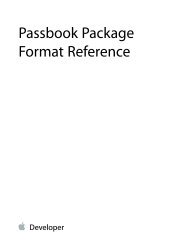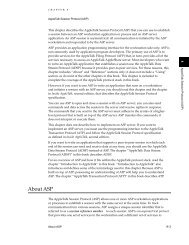URL Loading System Programming Guide - Apple Developer
URL Loading System Programming Guide - Apple Developer
URL Loading System Programming Guide - Apple Developer
You also want an ePaper? Increase the reach of your titles
YUMPU automatically turns print PDFs into web optimized ePapers that Google loves.
Understanding Cache Access<br />
Cache Use Semantics for the HTTP Protocol<br />
Note: Currently, only responses to HTTP and HTTPS requests are cached. The FTP and file protocols<br />
attempt to access the originating source as allowed by the cache policy. Custom NS<strong>URL</strong>Protocol<br />
classes can optionally provide caching.<br />
Cache Use Semantics for the HTTP Protocol<br />
The most complicated cache use situation is when a request uses the HTTP protocol and has set the cache<br />
policy to NS<strong>URL</strong>RequestUseProtocolCachePolicy.<br />
If an NSCached<strong>URL</strong>Response does not exist for the request, then the <strong>URL</strong> loading system fetches the data<br />
from the originating source.<br />
If a cached response exists for the request, the <strong>URL</strong> loading system checks the response to determine if it<br />
specifies that the contents must be revalidated.<br />
If the contents must be revalidated, the <strong>URL</strong> loading system makes a HEAD request to the originating source<br />
to see if the resource has changed. If it has not changed, then the <strong>URL</strong> loading system returns the cached<br />
response. If it has changed, the <strong>URL</strong> loading system fetches the data from the originating source.<br />
If the cached response doesn’t specify that the contents must be revalidated, the <strong>URL</strong> loading system examines<br />
the maximum age or expiration specified in the cached response. If the cached response is recent enough,<br />
then the <strong>URL</strong> loading system returns the cached response. If the response is stale, the <strong>URL</strong> loading system<br />
makes a HEAD request to the originating source to determine whether the resource has changed. If so, the<br />
<strong>URL</strong> loading system fetches the resource from the originating source. Otherwise, it returned the cached response.<br />
RFC 2616, Section 13 (http://www.w3.org/Protocols/rfc2616/rfc2616-sec13.html#sec13) specifies the semantics<br />
involved in detail.<br />
Controlling Caching Programmatically<br />
By default, the data for a connection is cached based on the request’s cache policy, as interpreted by the<br />
NS<strong>URL</strong>Protocol subclass that handles the request.<br />
If your app needs more precise programmatic control over caching (and if the protocol supports caching), you<br />
can implement a delegate method that allows your app to determine on a per-request basis whether a particular<br />
response should be cached.<br />
●<br />
For NS<strong>URL</strong>Session data and upload tasks, implement the<br />
<strong>URL</strong>Session:dataTask:willCacheResponse:completionHandler: method.<br />
2013-10-22 | Copyright © 2003, 2013 <strong>Apple</strong> Inc. All Rights Reserved.<br />
59
















